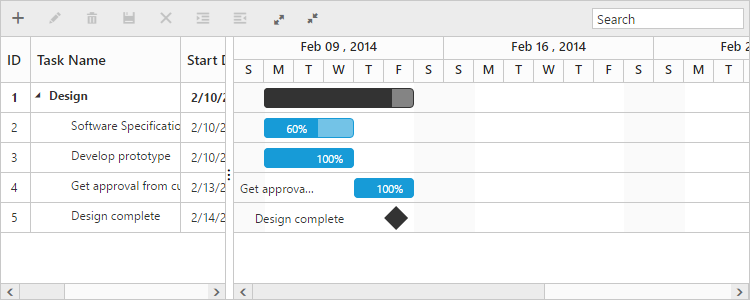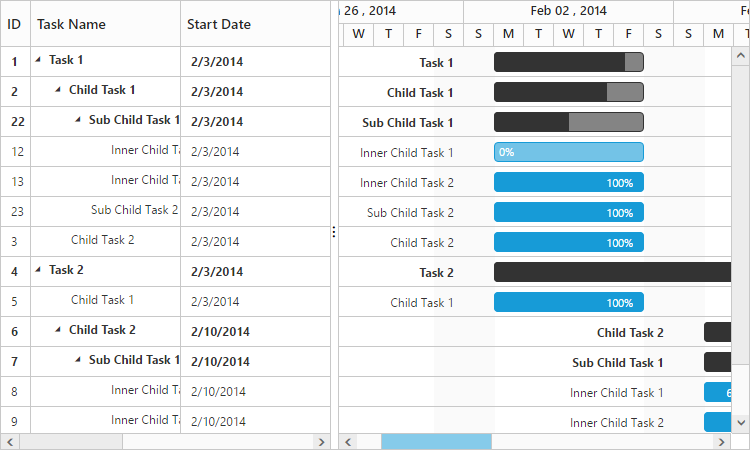Data binding
8 Mar 201812 minutes to read
The data binding is the process that establishes a connection between the application and different kinds of data sources such as business objects. You can bind the local data and remote data in the Gantt.
Local data binding
In local data binding, the data source for rendering the Gantt control is retrieved from the same application locally.
Two types of data binding are possible with the Gantt control:
- Hierarchical data source binding
- Self-referential data binding (flat data)
Hierarchical data source binding
The following code example explains how to bind the hierarchical data in Gantt:
<script>
var taskDetails = [{
taskID: 1,
taskName: "Design",
startDate: new Date("02/10/2014"),
endDate: new Date("02/14/2014"),
baselineStartDate: new Date("02/10/2014"),
baselineEndDate: new Date("02/12/2014"),
duration: 5,
subtasks: [
{
taskID: 2,
taskName: "Software Specification",
startDate: new Date("02/10/2014"),
endDate: new Date("02/12/2014"),
baselineStartDate: new Date("02/10/2014"),
baselineEndDate: new Date("02/12/2014"),
duration: 4,
progress: "60",
resourceId: [2]
},
{
taskID: 3,
taskName: "Develop prototype",
startDate: new Date("02/10/2014"),
endDate: new Date("02/12/2014"),
baselineStartDate: new Date("02/10/2014"),
baselineEndDate: new Date("02/12/2014"),
duration: 4,
progress: "70",
resourceId: [3]
},
//...
]
}];
angular.module('listCtrl', ['ejangular'])
.controller('GanttCtrl', function ($scope) {
//...
$scope.taskDetails="taskDetails";
});
<script>
<body ng-controller="GanttCtrl">
<!--Add Gantt control here-->
<div id="GanttContainer" ej-gantt
//...
e-datasource= "taskDetails"
e-taskidmapping= "taskID"
e-tasknamemapping= "taskName"
e-schedulestartdate= "02/01/2014"
e-scheduleenddate= "03/14/2014"
e-startdatemapping= "startDate"
e-durationmapping= "duration"
e-progressmapping= "progress"
e-childmapping= "subtasks"
e-treecolumnindex= 1
>
</div>The output of the above steps is as follows:

You can set the data source to Gantt by using the ejDataManager. The following code example explains how to assign the ejDataManager instance to the Gantt:
<body ng-controller="GanttCtrl">
<!--Add Gantt control here-->
<div id="GanttContainer" ej-gantt
e-datasource= "taskDetails"
//...
>
</div>
<script>
angular.module('listCtrl', ['ejangular'])
.controller('GanttCtrl', function($scope) {
//...
$scope.taskDetails = ej.DataManager(dataManger);
});
</script>Self-referential data binding (flat data)
The Gantt can be rendered from self-referential data structures by mapping the task ID and parent task ID fields.
- Task ID field: This field must contain unique values to identify the nodes. It should be mapped to the
e-taskidmappingproperty. - Parent task ID field: This field must contain values to identify the parent nodes. It should be mapped to the
e-parenttaskidmappingproperty.
<script>
var projectData = [
{ taskID: 1, taskName: "Task 1", startDate: "02/03/2014", endDate: "03/07/2014", duration: 5},
{ taskID: 2, pId: 1, taskName: "Child Task 1", startDate: "02/03/2014", endDate: "02/07/2014", duration: 5},
{ taskID: 3, pId: 1, taskName: "Child Task 2", startDate: "02/03/2014", endDate: "02/07/2014", duration: 5, progress: "100" },
{ taskID: 22, pId: 2, taskName: "Sub Child Task 1", startDate: "02/03/2014", endDate: "02/07/2014", duration: 5 },
{ taskID: 23, pId: 2, taskName: "Sub Child Task 2", startDate: "02/03/2014", endDate: "02/07/2014", duration: 5, progress: "100" },
{ taskID: 12, pId: 22, taskName: "Inner Child Task 1", startDate: "02/03/2014", endDate: "02/07/2014", duration: 5},
{ taskID: 13, pId: 22, taskName: "Inner Child Task 2", startDate: "02/03/2014", endDate: "02/07/2014", duration: 5, progress: "100"},
{ taskID: 4, taskName: "Task 2", startDate: "02/03/2014", endDate: "02/07/2014", duration: 5, progress: "100"},
{ taskID: 5, pId: 4, taskName: "Child Task 1", startDate: "02/03/2014", endDate: "02/07/2014", duration: 5, progress: "100" },
{ taskID: 6, pId: 4, taskName: "Child Task 2", startDate: "02/07/2014", endDate: "02/07/2014", duration: 5},
{ taskID: 7, pId: 6, taskName: "Sub Child Task 1", startDate: "02/07/2014", endDate: "02/07/2014", duration: 5},
{ taskID: 8, pId: 7, taskName: "Inner Child Task 1", startDate: "02/10/2014", endDate: "02/12/2014", duration: 3, progress: "60"},
{ taskID: 9, pId: 7, taskName: "Inner Child Task 2", startDate: "02/10/2014", endDate: "02/12/2014", duration: 3, progress: "100" },
{ taskID: 10, taskName: "Task 3", startDate: "02/13/2014", endDate: "02/14/2014", duration: 2, progress: "100"},
{ taskID: 11, taskName: "Task 4", startDate: "02/14/2014", endDate: "02/14/2014", duration: 0, }];
angular.module('listCtrl', ['ejangular'])
.controller('GanttCtrl', function ($scope) {
//...
$scope.taskDetails="projectData";
});
</script>
<body ng-controller="GanttCtrl">
<!--Add Gantt control here-->
<div id="GanttContainer" ej-gantt
//...
e-datasource= "taskDetails"
e-taskidmapping= "taskID"
e-parenttaskidmapping= "pId",
e-enablevirtualization= "true",
e-highlightweekends="true",
e-includeweekend= false,
e-tasknamemapping= "taskName"
e-schedulestartdate= "02/01/2014"
e-scheduleenddate= "03/14/2014"
e-startdatemapping= "startDate"
e-enddatemapping= "endDate",
e-durationmapping= "duration"
e-progressmapping= "progress"
e-childmapping= "subtasks"
e-treecolumnindex= 1
>
</div>The following screenshot shows the output of the previous steps:

Remote data
You can load remote data in the Gantt by using the ej.DataManager. You can assign the web service data as an ej.DataManager instance to the data source property. The following example explains how to load the remote data in the Gantt:
<script>
var dataManger = ej.DataManager({
url: "http://mvc.syncfusion.com/Services/Northwnd.svc/Orders",
offline: true
});
angular.module('listCtrl', ['ejangular'])
.controller('GanttCtrl', function ($scope) {
//...
$scope.dataManger="dataManger";
});
</script>
<body ng-controller="GanttCtrl">
<!--Add Gantt control here-->
<div id="GanttContainer" ej-gantt
//...
e-datasource= "dataManger"
>
</div>
</body>